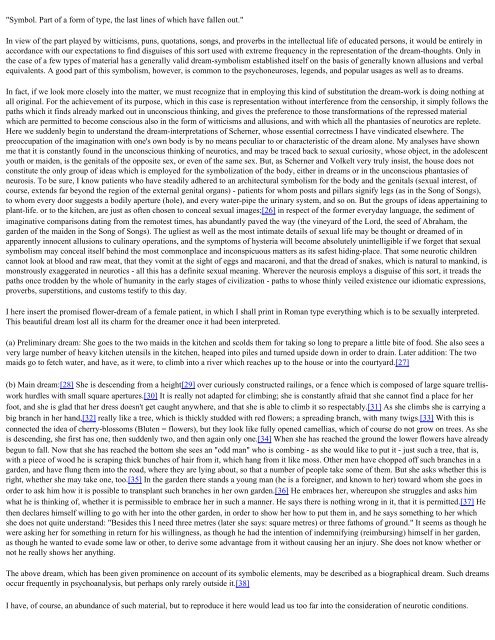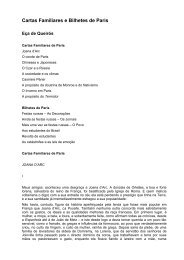The Interpretation of Dreams Sigmund Freud (1900)
The Interpretation of Dreams Sigmund Freud (1900)
The Interpretation of Dreams Sigmund Freud (1900)
Create successful ePaper yourself
Turn your PDF publications into a flip-book with our unique Google optimized e-Paper software.
"Symbol. Part <strong>of</strong> a form <strong>of</strong> type, the last lines <strong>of</strong> which have fallen out."<br />
In view <strong>of</strong> the part played by witticisms, puns, quotations, songs, and proverbs in the intellectual life <strong>of</strong> educated persons, it would be entirely in<br />
accordance with our expectations to find disguises <strong>of</strong> this sort used with extreme frequency in the representation <strong>of</strong> the dream-thoughts. Only in<br />
the case <strong>of</strong> a few types <strong>of</strong> material has a generally valid dream-symbolism established itself on the basis <strong>of</strong> generally known allusions and verbal<br />
equivalents. A good part <strong>of</strong> this symbolism, however, is common to the psychoneuroses, legends, and popular usages as well as to dreams.<br />
In fact, if we look more closely into the matter, we must recognize that in employing this kind <strong>of</strong> substitution the dream-work is doing nothing at<br />
all original. For the achievement <strong>of</strong> its purpose, which in this case is representation without interference from the censorship, it simply follows the<br />
paths which it finds already marked out in unconscious thinking, and gives the preference to those transformations <strong>of</strong> the repressed material<br />
which are permitted to become conscious also in the form <strong>of</strong> witticisms and allusions, and with which all the phantasies <strong>of</strong> neurotics are replete.<br />
Here we suddenly begin to understand the dream-interpretations <strong>of</strong> Scherner, whose essential correctness I have vindicated elsewhere. <strong>The</strong><br />
preoccupation <strong>of</strong> the imagination with one's own body is by no means peculiar to or characteristic <strong>of</strong> the dream alone. My analyses have shown<br />
me that it is constantly found in the unconscious thinking <strong>of</strong> neurotics, and may be traced back to sexual curiosity, whose object, in the adolescent<br />
youth or maiden, is the genitals <strong>of</strong> the opposite sex, or even <strong>of</strong> the same sex. But, as Scherner and Volkelt very truly insist, the house does not<br />
constitute the only group <strong>of</strong> ideas which is employed for the symbolization <strong>of</strong> the body, either in dreams or in the unconscious phantasies <strong>of</strong><br />
neurosis. To be sure, I know patients who have steadily adhered to an architectural symbolism for the body and the genitals (sexual interest, <strong>of</strong><br />
course, extends far beyond the region <strong>of</strong> the external genital organs) - patients for whom posts and pillars signify legs (as in the Song <strong>of</strong> Songs),<br />
to whom every door suggests a bodily aperture (hole), and every water-pipe the urinary system, and so on. But the groups <strong>of</strong> ideas appertaining to<br />
plant-life. or to the kitchen, are just as <strong>of</strong>ten chosen to conceal sexual images;[26] in respect <strong>of</strong> the former everyday language, the sediment <strong>of</strong><br />
imaginative comparisons dating from the remotest times, has abundantly paved the way (the vineyard <strong>of</strong> the Lord, the seed <strong>of</strong> Abraham, the<br />
garden <strong>of</strong> the maiden in the Song <strong>of</strong> Songs). <strong>The</strong> ugliest as well as the most intimate details <strong>of</strong> sexual life may be thought or dreamed <strong>of</strong> in<br />
apparently innocent allusions to culinary operations, and the symptoms <strong>of</strong> hysteria will become absolutely unintelligible if we forget that sexual<br />
symbolism may conceal itself behind the most commonplace and inconspicuous matters as its safest hiding-place. That some neurotic children<br />
cannot look at blood and raw meat, that they vomit at the sight <strong>of</strong> eggs and macaroni, and that the dread <strong>of</strong> snakes, which is natural to mankind, is<br />
monstrously exaggerated in neurotics - all this has a definite sexual meaning. Wherever the neurosis employs a disguise <strong>of</strong> this sort, it treads the<br />
paths once trodden by the whole <strong>of</strong> humanity in the early stages <strong>of</strong> civilization - paths to whose thinly veiled existence our idiomatic expressions,<br />
proverbs, superstitions, and customs testify to this day.<br />
I here insert the promised flower-dream <strong>of</strong> a female patient, in which I shall print in Roman type everything which is to be sexually interpreted.<br />
This beautiful dream lost all its charm for the dreamer once it had been interpreted.<br />
(a) Preliminary dream: She goes to the two maids in the kitchen and scolds them for taking so long to prepare a little bite <strong>of</strong> food. She also sees a<br />
very large number <strong>of</strong> heavy kitchen utensils in the kitchen, heaped into piles and turned upside down in order to drain. Later addition: <strong>The</strong> two<br />
maids go to fetch water, and have, as it were, to climb into a river which reaches up to the house or into the courtyard.[27]<br />
(b) Main dream:[28] She is descending from a height[29] over curiously constructed railings, or a fence which is composed <strong>of</strong> large square trelliswork<br />
hurdles with small square apertures.[30] It is really not adapted for climbing; she is constantly afraid that she cannot find a place for her<br />
foot, and she is glad that her dress doesn't get caught anywhere, and that she is able to climb it so respectably.[31] As she climbs she is carrying a<br />
big branch in her hand,[32] really like a tree, which is thickly studded with red flowers; a spreading branch, with many twigs.[33] With this is<br />
connected the idea <strong>of</strong> cherry-blossoms (Bluten = flowers), but they look like fully opened camellias, which <strong>of</strong> course do not grow on trees. As she<br />
is descending, she first has one, then suddenly two, and then again only one.[34] When she has reached the ground the lower flowers have already<br />
begun to fall. Now that she has reached the bottom she sees an "odd man" who is combing - as she would like to put it - just such a tree, that is,<br />
with a piece <strong>of</strong> wood he is scraping thick bunches <strong>of</strong> hair from it, which hang from it like moss. Other men have chopped <strong>of</strong>f such branches in a<br />
garden, and have flung them into the road, where they are lying about, so that a number <strong>of</strong> people take some <strong>of</strong> them. But she asks whether this is<br />
right, whether she may take one, too.[35] In the garden there stands a young man (he is a foreigner, and known to her) toward whom she goes in<br />
order to ask him how it is possible to transplant such branches in her own garden.[36] He embraces her, whereupon she struggles and asks him<br />
what he is thinking <strong>of</strong>, whether it is permissible to embrace her in such a manner. He says there is nothing wrong in it, that it is permitted.[37] He<br />
then declares himself willing to go with her into the other garden, in order to show her how to put them in, and he says something to her which<br />
she does not quite understand: "Besides this I need three metres (later she says: square metres) or three fathoms <strong>of</strong> ground." It seems as though he<br />
were asking her for something in return for his willingness, as though he had the intention <strong>of</strong> indemnifying (reimbursing) himself in her garden,<br />
as though he wanted to evade some law or other, to derive some advantage from it without causing her an injury. She does not know whether or<br />
not he really shows her anything.<br />
<strong>The</strong> above dream, which has been given prominence on account <strong>of</strong> its symbolic elements, may be described as a biographical dream. Such dreams<br />
occur frequently in psychoanalysis, but perhaps only rarely outside it.[38]<br />
I have, <strong>of</strong> course, an abundance <strong>of</strong> such material, but to reproduce it here would lead us too far into the consideration <strong>of</strong> neurotic conditions.









